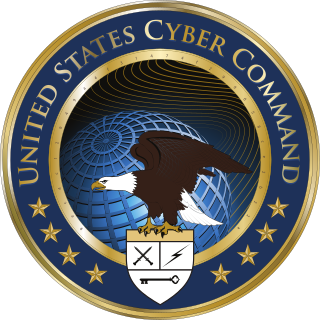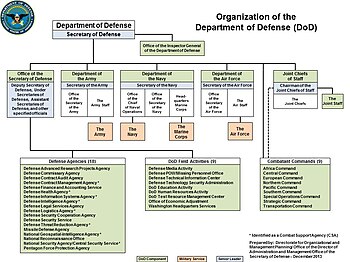The United States Armed Forces are the military forces of the United States. The armed forces consists of six service branches: the Army, Marine Corps, Navy, Air Force, Space Force, and Coast Guard. All six armed services are among the eight uniformed services of the United States.

The Defense Intelligence Agency (DIA) is an intelligence agency and combat support agency of the United States Department of Defense, specializing in defense and military intelligence.

The National Geospatial-Intelligence Agency (NGA) is a combat support agency within the United States Department of Defense whose primary mission is collecting, analyzing, and distributing geospatial intelligence (GEOINT) in support of national security. Initially known as the National Imagery and Mapping Agency (NIMA) from 1996 to 2003, it is a member of the United States Intelligence Community.
A security clearance is a status granted to individuals allowing them access to classified information or to restricted areas, after completion of a thorough background check. The term "security clearance" is also sometimes used in private organizations that have a formal process to vet employees for access to sensitive information. A clearance by itself is normally not sufficient to gain access; the organization must also determine that the cleared individual needs to know specific information. No individual is supposed to be granted automatic access to classified information solely because of rank, position, or a security clearance.

The United States Intelligence Community (IC) is a group of separate United States government intelligence agencies and subordinate organizations that work both separately and collectively to conduct intelligence activities which support the foreign policy and national security interests of the United States. Member organizations of the IC include intelligence agencies, military intelligence, and civilian intelligence and analysis offices within federal executive departments.

The Central Security Service (CSS) is a combat support agency of the United States Department of Defense which was established in 1972 to integrate the National Security Agency (NSA) and the Service Cryptologic Components (SCC) of the United States Armed Forces in the field of signals intelligence, cryptology, and information assurance at the tactical level. In 2002, the CSS had approximately 25,000 uniformed members. It is part of the United States Intelligence Community.

The Texas Air National Guard (TX ANG) is the aerial militia of the State of Texas, United States of America. It is, along with the Texas Army National Guard, an element of the Texas National Guard. No element of the Texas Air National Guard is under United States Air Force command. They are under the jurisdiction of the Governor of Texas through the office of the Texas Adjutant General unless they are federalized by order of the President of the United States. The Texas Air National Guard is headquartered at Camp Mabry, Austin, and its chief of staff is Brigadier General Matthew Barker.
The United States government classification system is established under Executive Order 13526, the latest in a long series of executive orders on the topic beginning in 1951. Issued by President Barack Obama in 2009, Executive Order 13526 replaced earlier executive orders on the topic and modified the regulations codified to 32 C.F.R. 2001. It lays out the system of classification, declassification, and handling of national security information generated by the U.S. government and its employees and contractors, as well as information received from other governments.
Special access programs (SAPs) in the U.S. Federal Government are security protocols that provide highly classified information with safeguards and access restrictions that exceed those for regular (collateral) classified information. SAPs can range from black projects to routine but especially-sensitive operations, such as COMSEC maintenance or presidential transportation support. In addition to collateral controls, an SAP may impose more stringent investigative or adjudicative requirements, specialized nondisclosure agreements, special terminology or markings, exclusion from standard contract investigations (carve-outs), and centralized billet systems. Within the Department of Defense, SAP is better known as "SAR" by the mandatory Special Access Required (SAR) markings.

The Nebraska Air National Guard (NE ANG) is the aerial militia of the State of Nebraska, United States of America. It is, along with the Nebraska Army National Guard, an element of the Nebraska National Guard.
The Assistant Secretary of Defense for Networks & Information Integration (ASD(NII)) was an appointed position that provided management and oversight of all DoD information technology, including national security systems. The ASD(NII) also served as the chief information officer (CIO) of the United States Department of Defense (DoD), a position distinct from the ASD and governed by the Clinger-Cohen Act.

The under secretary of defense for intelligence and security or USD(I&S) is a high-ranking civilian position in the Office of the Secretary of Defense (OSD) within the U.S. Department of Defense (DoD) that acts as the principal civilian advisor and deputy to the secretary of defense (SecDef) and deputy secretary of defense (DepSecDef) on matters relating to military intelligence and security. The under secretary is appointed as a civilian by the president and confirmed by the Senate to serve at the pleasure of the president.

The United States Department of Defense is an executive branch department of the federal government of the United States charged with coordinating and supervising all agencies and functions of the U.S. government directly related to national security and the United States Armed Forces. The DoD is the largest employer in the world, with over 1.34 million active-duty service members as of June 2022. The DoD also maintains over 778,000 National Guard and reservists, and over 747,000 civilians bringing the total to over 2.87 million employees. Headquartered at the Pentagon in Arlington, Virginia, just outside Washington, D.C., the DoD's stated mission is to provide "the military forces needed to deter war and ensure our nation's security".
The counter-terrorism page primarily deals with special police or military organizations that carry out arrest or direct combat with terrorists. This page deals with the other aspects of counter-terrorism:

United States Cyber Command (USCYBERCOM) is one of the eleven unified combatant commands of the United States Department of Defense (DoD). It unifies the direction of cyberspace operations, strengthens DoD cyberspace capabilities, and integrates and bolsters DoD's cyber expertise.

The structure of the United States Army is complex, and can be interpreted in several different ways: active/reserve, operational/administrative, and branches/functional areas.

The National Intelligence University (NIU) is a federally chartered research university in Bethesda, Maryland operated by and for the United States Intelligence Community (IC) as its staff college of higher learning in fields of study central to the profession of intelligence and national security. A small, highly selective non-residential university, NIU awards undergraduate and graduate degrees, a graduate certificate, and prestigious research fellowships to prepare personnel for critical positions in the IC and the broader national security enterprise. Since 1963, more than 80,000 military and civilian students have attended the university. Originally located at Defense Intelligence Agency headquarters at Joint Base Anacostia–Bolling in Washington, D.C., NIU's primary campus is now located just up the Potomac River at Intelligence Community Campus-Bethesda (ICC-B) with four additional locations around the world.

United States Army Counterintelligence (ACI) is the component of United States Army Military Intelligence which conducts counterintelligence activities to detect, identify, assess, counter, exploit and/or neutralize adversarial, foreign intelligence services, international terrorist organizations, and insider threats to the United States Army and U.S. Department of Defense (DoD).












